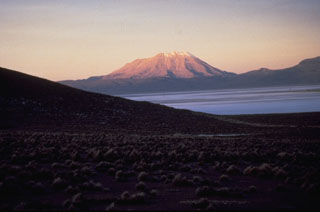Report on Ubinas (Peru) — 11 June-17 June 2014
Smithsonian Institution / US Geological Survey
Weekly Volcanic Activity Report, 11 June-17 June 2014
Managing Editor: Sally Sennert.
Please cite this report as:
Global Volcanism Program, 2014. Report on Ubinas (Peru) (Sennert, S, ed.). Weekly Volcanic Activity Report, 11 June-17 June 2014. Smithsonian Institution and US Geological Survey.
Ubinas
Peru
16.345°S, 70.8972°W; summit elev. 5608 m
All times are local (unless otherwise noted)
In a 12 June press release, IGP's Observatorio Volcanologico de Arequipa (IGP-OVA) reported that activity at Ubinas had decreased since April, however periods of intense tremor mainly associated with ash emissions continued to be detected. Ashfall affected areas around the volcano, especially within 6 km E and SSW. An IGP update on 17 June noted a small explosion at 1335 that day that sent ash 1,800 m above the crater, to an altitude of about 7,400 m (24,500 ft) a.s.l.
Geological Summary. The truncated appearance of Ubinas, Perú's most active volcano, is a result of a 1.4-km-wide crater at the summit. It is the northernmost of three young volcanoes located along a regional structural lineament about 50 km behind the main volcanic front. The growth and destruction of Ubinas I was followed by construction of Ubinas II beginning in the mid-Pleistocene. The upper slopes of the andesitic-to-rhyolitic Ubinas II stratovolcano are composed primarily of andesitic and trachyandesitic lava flows and steepen to nearly 45°. The steep-walled, 150-m-deep summit crater contains an ash cone with a 500-m-wide funnel-shaped vent that is 200 m deep. Debris-avalanche deposits from the collapse of the SE flank about 3,700 years ago extend 10 km from the volcano. Widespread Plinian pumice-fall deposits include one from about 1,000 years ago. Holocene lava flows are visible on the flanks, but activity documented since the 16th century has consisted of intermittent minor-to-moderate explosive eruptions.
Sources: Instituto Geofísico del Perú (IGP), Instituto Geológico Minero y Metalúrgico (INGEMMET)

